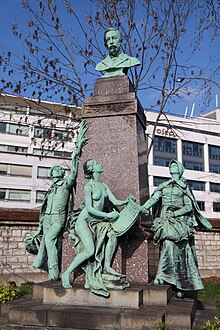Edmond Nocard
Edmond Nocard (born January 29, 1850 in Provins , † August 2, 1903 in Saint-Maurice , Département Val-de-Marne ) was a French veterinarian and bacteriologist as well as a pioneer in microbiology and infectious diseases . The bacterial genus Nocardia is named after him.
Career
Edmond Nocard studied veterinary medicine at the Maisons-Alfort School of Veterinary Medicine from 1868 to 1871 . In 1871 he was called up for military service due to the Franco-Prussian War , but was able to continue his studies afterwards and received the diploma as a veterinarian in 1873. From 1873 to 1878 he worked at the school's clinic. In 1876 he was given the job of editing the new specialist journal Les Archives Vétérinaires , in which he published various articles on internal medicine, surgery, hygiene and law in veterinary medicine. In 1878 he received a professorship for clinical and surgical veterinary medicine in Alfort. There were many important researchers among his students, including Camille Guérin and Henri Carré .
1880 changed Nocard as an assistant in the laboratory of Louis Pasteur in Paris, where he collaborated with Pasteur and Emile Roux in the development of the of Henry Toussaint invented the vaccine against anthrax worked. In 1883 he went to Egypt with Roux, where he investigated a cholera epidemic , but was unable to isolate the pathogen. Later that year he returned to Alfort, where, with Pasteur's support, he set up a microbiological research laboratory that would later become the Laboratoire National de Recherches . In the following three years he developed several new bacteriological techniques, including new culture media for Mycobacterium tuberculosis , the causative agent of tuberculosis . In his clinical work he introduced intravenous anesthesia with chloral hydrate in farm animals and dealt with tetanus prevention .
In 1887 he was promoted to rector of the veterinary school and chairman of the infectious diseases division. In 1888 he was a member of the first editorial team of the Annales de l'Institut Pasteur magazine . The Pasteur Institute made him a full member in 1895. From 1892 to 1896, like Saturnin Arloing, he campaigned for the practical use of tuberculin developed by Robert Koch to combat bovine tuberculosis, which is also dangerous for humans . During this time he published his book La Tuberculose Bovine: ses Dangers, ses Rapports avec la tuberculose humaine classique .
Another contribution Nocard made to veterinary medicine was the discovery of the bacterial genus Nocardia , later named after him , the first known organism of which he described in 1888 as Streptothrix farcinica . The bacteria in this genus cause nocardiosis . He also discovered an important pathogen causing udder inflammation in cows, Streptococcus agalactiae , the pathogen causing pseudotuberculosis and, with the pathogen causing lung disease in cattle, the first pathogen from the mycoplasma group .
literature
- Chauvau, E. Leclainche, E. Roux, Edmond Nocard 1850-1903 , Paris, Masson et Cie éd., 1906, 85 pages
- Doris Schwarzmann-Schafhauser: Nocard, Edmond. In: Werner E. Gerabek , Bernhard D. Haage, Gundolf Keil , Wolfgang Wegner (eds.): Enzyklopädie Medizingeschichte. De Gruyter, Berlin / New York 2005, ISBN 3-11-015714-4 , p. 1055.
Web links
- Edmond Nocard's biography on the Institut Pasteur website
| personal data | |
|---|---|
| SURNAME | Nocard, Edmond |
| ALTERNATIVE NAMES | Nocard, Edmond Isidore Etienne (full name) |
| BRIEF DESCRIPTION | French veterinarian and microbiologist |
| DATE OF BIRTH | January 29, 1850 |
| PLACE OF BIRTH | Provins |
| DATE OF DEATH | August 2, 1903 |
| Place of death | Saint-Maurice (Val-de-Marne) |

